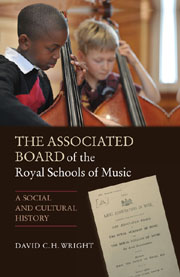Book contents
- Frontmatter
- Contents
- List of Illustrations
- List of Tables
- Dedication
- Preface
- List of Abbreviations
- Miscellaneous Conventions
- Introduction: The Context for a History
- I THE BACKGROUND
- II THE BOARD ESTABLISHED, 1889–1920
- III THE INSTITUTIONAL CULTURE, 1920–83
- IV THE BOARD REVIVED, 1983–2009
- Appendix 1 Speech and Drama Examinations
- Appendix 2 ABRSM Personalia, 1889–2010
- Select Bibliography
- Index
Introduction: The Context for a History
Published online by Cambridge University Press: 05 July 2013
- Frontmatter
- Contents
- List of Illustrations
- List of Tables
- Dedication
- Preface
- List of Abbreviations
- Miscellaneous Conventions
- Introduction: The Context for a History
- I THE BACKGROUND
- II THE BOARD ESTABLISHED, 1889–1920
- III THE INSTITUTIONAL CULTURE, 1920–83
- IV THE BOARD REVIVED, 1983–2009
- Appendix 1 Speech and Drama Examinations
- Appendix 2 ABRSM Personalia, 1889–2010
- Select Bibliography
- Index
Summary
The Associated Board
THE Associated Board of the Royal Schools of Music (ABRSM) is the extramural examining body set up by the Royal Academy of Music and the Royal College of Music in 1889. The Royal Manchester College of Music (now the Royal Northern College of Music) and the Royal Scottish Academy of Music and Drama (now the Royal Conservatoire of Scotland) joined the Board as subsidiary partners in 1947, becoming full partners in a major restructuring of the ABRSM that took place in 1985. (To avoid the tedious repetition of its acronym, I shall refer to the ABRSM variously in the text as ‘the Associated Board’ or just ‘the Board’.)
What is the Associated Board, and what does it represent? Despite its ubiquitous presence in music education, relatively few know much about this institution and the basis on which it determines standards, writes syllabuses and runs its exams. In fact the Board is one of the significant legacies of Victorian Britain, generated as part of that society's concern to expand the technological and professional workforce needed to run the Empire. And, as with some other Victorian inceptions, the Board's system of exams – designed to provide for the objective assessment of progress in learning an instrument or voice, and applied on an industrial scale – was a symbiosis of educational purpose and entrepreneurial enterprise. Moreover the system has proved itself remarkably adaptable in meeting the changes in educational and musical environments during the course of its history.
- Type
- Chapter
- Information
- The Associated Board of the Royal Schools of MusicA Social and Cultural History, pp. 1 - 16Publisher: Boydell & BrewerPrint publication year: 2013



